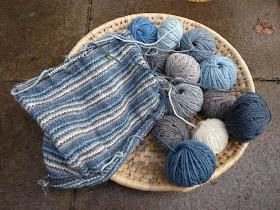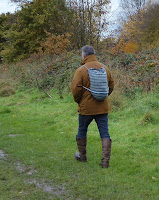A Tale of Two Filoplumes.
Hearing the hoofsteps of my companion, Elinor Gotland, I clicked off the Ravelry page and opened my email. She leaned over my shoulder.
"Can't fool me, Beaut. You've been looking at shawl patterns again, haven't you?"
I stopped pretending to renew the car insurance.
"I haven't knitted a shawl for ages and all my friends are talking about the new designs. Really, I'm just trying to use up my stash - there's a couple of variegated skeins of yarn just crying out to become something lovely."
Elinor was unmoved.
"You don't need another shawl."
"I'm thinking of Christmas presents."
A remorseless hoof prodded me toward the kitchen.
"You've already given at least one shawl to every woman you know who would wear one and several who wouldn't. Anyway, engage brain, think about your priorities for just one moment. Start doing beaded lace knitting now and it'll take you til Easter to finish. If you've got enough spare time for Christmas preparations, you can defrost this freezer."
The worst thing about my companion is her good advice. Of course, I sneaked back to the computer later on, just to catch up with the gossip on Ravelry. When I saw that Bex had published a new shawl pattern called Filoplume, I was intrigued by its angled spine. And the name - a filoplume turns out to be kind of tufted feather, specialised for sensing a bird's flight speed and the wind direction. Donna had test knitted the shawl in a rainbow gradient as glorious as a peacock's tail display and it proved quite irresistible. I pressed that 'Shop Now' button and Elinor arrived just in time for the printer to drop the pattern onto her head. She picked up the sheets of paper and gave me one of her 'disappointed but not surprised' looks.
"It's not lace, this one's an easy knit, Elinor, I'll have no trouble getting it done before the holidays." I sprinted upstairs to fetch my prettiest yarn.
Two false starts later, I wished I wasn't such an impulsive wool shopper.
"I might have to buy one of those cakes of gradient yarn, Elinor. This more subtly variegated skein just looks muddy in garter stitch ridges and the vibrant one I tried first was too lively all by itself. No-one could wear that much zing, I think I'll have to save it to be an accent on a solid background. Maybe I should buy some soft mid-grey."
"You are NOT buying any more yarn. What about all your handspun skeins, keeping them as a Christmas treat for the moths, are you?"
"A shawl has to be supersoft and luxurious. My spinning is mostly ... well, characterful yarn from British breeds of sheep."
 "What about that cashmere you blended on a board years ago? That was lovely and soft. What became of that?"
"What about that cashmere you blended on a board years ago? That was lovely and soft. What became of that?"
"I spun it three ply, lace knitting is better with two ply."
"You said this wasn't a lace shawl."
"No, but I can't remember how much yardage there was in those balls of cashmere."
"That doesn't matter, look, the Filoplume pattern tells you how to weigh your yarn so you have exactly enough to finish the shape for any size of shawl."
"But it's BORING BEIGE yarn. I did start knitting with it years ago and lost the will to go on. It's all in a bag somewhere."
"Fetch it out and use it up."
"Ohhhh. This shawl will be small and dull and no fun at all. Is that ringing any bells, Elinor?"
The Filoplume pattern is well thought out and highly satisfying, as I said to my companion while showing off my progress.
"I love the nifty trick with two stitch markers that means you never have to count rows to find out when to make the increases and you can see at once where you've got to when you pick your knitting back up."
"Shame you've purled a row back there and spoiled the garter stitch."
"Oh, bugger." I stared at the flat line of the accidental stocking stitch row. "Actually, I think I'll do that again. With such a bland yarn, I can afford to vary the texture."
Even with smoother stripes, my mottled beige yarn wasn't going to highlight the construction, so I added a few garter stitch ridges in dark brown alpaca. Section one forms a symmetrically expanding arrowhead shape.
Here's where I had got to just after the weight of the yarn remaining told me I had to move on to section two of the pattern.
The finished item aka 'The Cashmaplume' had 15 increases in section one, the whole thing measures 140cm across the long side and weighs 116g. A few more stocking stitch stripes and alpaca ridges show how section two develops asymmetrically to resolve the shawl as an obtuse triangle.
"I'm so glad I decided to go with a neutral colourway."
Elinor did a double take.
I went on.
"You do realise I haven't knitted an undersized shawl, this is the ideal shape and length to be a rather classy, formal, cashmere men's scarf. Himself has already taken a fancy to wearing it under his coat. I think I'll knit another one for my brother. More casual, thicker and bigger, a scarf to wear with jeans and jumper. I'll use some of that double knitting merino yarn I dip dyed in an indigo vat last summer."
Here's The Indigoomaplume, modelled on the dogwalk, rather than the catwalk, knitted in dk on 4.5mm needles, 9 repeats in section one, 160cm long and weighing in at 150g.
Hearing the hoofsteps of my companion, Elinor Gotland, I clicked off the Ravelry page and opened my email. She leaned over my shoulder.
"Can't fool me, Beaut. You've been looking at shawl patterns again, haven't you?"
I stopped pretending to renew the car insurance.
"I haven't knitted a shawl for ages and all my friends are talking about the new designs. Really, I'm just trying to use up my stash - there's a couple of variegated skeins of yarn just crying out to become something lovely."
Elinor was unmoved.
"You don't need another shawl."
"I'm thinking of Christmas presents."
A remorseless hoof prodded me toward the kitchen.
"You've already given at least one shawl to every woman you know who would wear one and several who wouldn't. Anyway, engage brain, think about your priorities for just one moment. Start doing beaded lace knitting now and it'll take you til Easter to finish. If you've got enough spare time for Christmas preparations, you can defrost this freezer."
The worst thing about my companion is her good advice. Of course, I sneaked back to the computer later on, just to catch up with the gossip on Ravelry. When I saw that Bex had published a new shawl pattern called Filoplume, I was intrigued by its angled spine. And the name - a filoplume turns out to be kind of tufted feather, specialised for sensing a bird's flight speed and the wind direction. Donna had test knitted the shawl in a rainbow gradient as glorious as a peacock's tail display and it proved quite irresistible. I pressed that 'Shop Now' button and Elinor arrived just in time for the printer to drop the pattern onto her head. She picked up the sheets of paper and gave me one of her 'disappointed but not surprised' looks.
"It's not lace, this one's an easy knit, Elinor, I'll have no trouble getting it done before the holidays." I sprinted upstairs to fetch my prettiest yarn.
Two false starts later, I wished I wasn't such an impulsive wool shopper.
"I might have to buy one of those cakes of gradient yarn, Elinor. This more subtly variegated skein just looks muddy in garter stitch ridges and the vibrant one I tried first was too lively all by itself. No-one could wear that much zing, I think I'll have to save it to be an accent on a solid background. Maybe I should buy some soft mid-grey."
"You are NOT buying any more yarn. What about all your handspun skeins, keeping them as a Christmas treat for the moths, are you?"
"A shawl has to be supersoft and luxurious. My spinning is mostly ... well, characterful yarn from British breeds of sheep."
 "What about that cashmere you blended on a board years ago? That was lovely and soft. What became of that?"
"What about that cashmere you blended on a board years ago? That was lovely and soft. What became of that?""I spun it three ply, lace knitting is better with two ply."
"You said this wasn't a lace shawl."
"No, but I can't remember how much yardage there was in those balls of cashmere."
"That doesn't matter, look, the Filoplume pattern tells you how to weigh your yarn so you have exactly enough to finish the shape for any size of shawl."
"But it's BORING BEIGE yarn. I did start knitting with it years ago and lost the will to go on. It's all in a bag somewhere."
"Fetch it out and use it up."
"Ohhhh. This shawl will be small and dull and no fun at all. Is that ringing any bells, Elinor?"
The Filoplume pattern is well thought out and highly satisfying, as I said to my companion while showing off my progress.
"I love the nifty trick with two stitch markers that means you never have to count rows to find out when to make the increases and you can see at once where you've got to when you pick your knitting back up."
"Shame you've purled a row back there and spoiled the garter stitch."
"Oh, bugger." I stared at the flat line of the accidental stocking stitch row. "Actually, I think I'll do that again. With such a bland yarn, I can afford to vary the texture."
Even with smoother stripes, my mottled beige yarn wasn't going to highlight the construction, so I added a few garter stitch ridges in dark brown alpaca. Section one forms a symmetrically expanding arrowhead shape.
Here's where I had got to just after the weight of the yarn remaining told me I had to move on to section two of the pattern.
The finished item aka 'The Cashmaplume' had 15 increases in section one, the whole thing measures 140cm across the long side and weighs 116g. A few more stocking stitch stripes and alpaca ridges show how section two develops asymmetrically to resolve the shawl as an obtuse triangle.
"I'm so glad I decided to go with a neutral colourway."
Elinor did a double take.
I went on.
"You do realise I haven't knitted an undersized shawl, this is the ideal shape and length to be a rather classy, formal, cashmere men's scarf. Himself has already taken a fancy to wearing it under his coat. I think I'll knit another one for my brother. More casual, thicker and bigger, a scarf to wear with jeans and jumper. I'll use some of that double knitting merino yarn I dip dyed in an indigo vat last summer."
Here's The Indigoomaplume, modelled on the dogwalk, rather than the catwalk, knitted in dk on 4.5mm needles, 9 repeats in section one, 160cm long and weighing in at 150g.
I recommend the Filoplume pattern unreservedly, not just because I know Bex and she is lovely. Thanks to her, I have had fun knitting, got two Christmas presents sorted remarkably quickly and quite a bit of stash used up. I might even have to go wool shopping again soon.














































